|
Posted by Romy the Cat on
06-21-2023
|
I cannot imagine that I started to work on Macondo over 20 years ago. How are all this time the Macondo axioms coupled with Milq DSET proved to be quite accurate and constantly delivered quite good predictable results. Yes, it is a pain in the ass to maintain 14 channels. But if I discipline myself and once a month undergo my audio hygiene ceremony, when I verify that old channels are properly calibrated, that it is not a big deal.
There was one event two years ago, over the duration of a week or two, then passivly loaded Tannoy Red driven by VFet through a truly mind-boggling performance, in fact the best that I ever heard in Audio. That made me literally to trash Macondo and to go for exploration of the Dannoy options. One of the greatest discoveries of that project was that Red damped by Sunspeak passive suspension reduces olon over-exaggerated colors. However all my experiments to repeat this initial amazing result failed. I was able to get some interesting results but the dynamic limitations always kicked in and as with everything else, if you acknowledge it, then you cannot live with it.
So, starting from yesterday how to turn my Macondo and Milq back to my listening room. However to have just my Macondo/Milq tandem is not enough for me and I want some part of the Dannoy effect, predictably and fully controlled.
I would like to make Macondo to love me in the way how Dannoy did it 2 years ago. It was absolutely amazing combination of integrity and humility that my old Macondo was not able to deliver. I will cover in this thread the progression of my experiments.
|
|
|
|
Posted by anthony on
06-21-2023
|
The more I get out and listen to other systems the more I appreciate Macondo/DSET mainly for the life-like dynamics offered. I am also sure that many of the people that listen to my version are unable to grasp just how dynamic the sound is compared to what they are used to...it takes time to appreciate. They use other descriptors like resolution, detail etc. but it all comes back to dynamics.
Can't wait to see what you come up with for Macondo 3.0 Romy.
|
|
|
|
Posted by Romy the Cat on
06-21-2023
|
|
Might I ask you what tweeter you use withy your Macondo and how you dive it?
|
|
|
|
Posted by anthony on
06-21-2023
|
It is a RAAL Lazy Ribbon with the integrated transformer doubling as DSET OPT. Surprisingly, I started with a 4th order high pass filter which has steadily migrated back to first order...and it works.
Next step is to trial a biradial horn for a bit more loading at the lower knee and to clean up dispersion a little (I think it will be audible), like these, but black...
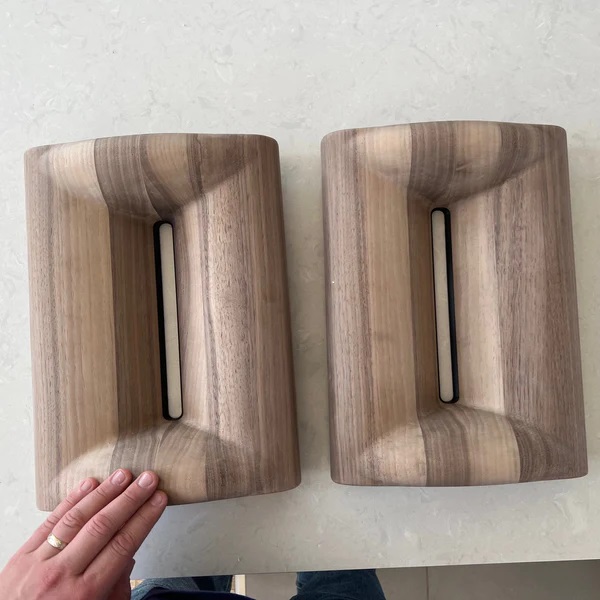
|
|
|
|
Posted by Romy the Cat on
06-22-2023
|
|
At the bottom of your RAAL you have Vitavox S2 driver with
no lowpass filter, right? Do you have an alternator between Milq and S2? If you
do, then the alternator has some inductance and acts and a very mild filter. Anyhow.
I disagree with RAAL and low order filter, and with horn loading RAAL but it is
not my playback, and you certainly can do whatever you want. I probably need to
record a video when I run my mouth about my ideas for Macondo 3.0 as it is too
long time to write. Will do it soon.
|
|
|
|
Posted by Amir on
06-22-2023
|
Reading this topic every day to learn how it is possible to have both "Dannoy effect" and "ultra dynamic and transparent" sound in one system is interesting to me, actually I always told we need to have two different audio systems, one emotional system and other Macro system. What I think is to have both sides in one audio system is not easy, What I mean is we get A at expense of giving B.
|
|
|
|
Posted by anthony on
06-23-2023
|
Yes, a cheap inductive l-pad between OPT and S2 in midrange channel. Interestingly, the frequency response of the first order Lazy Ribbon is remarkably similar to a response you posted somewhere on this site of the Water Drop with third order filter...really similar in the low end. I think I can do better with the Lazy Ribbon as I still have a slight but broad dip in the frequency response between where the S2 signs off and the RAAL picks up which the horn loading may or may not alleviate without having to lower the high pass filter from circa 10k to say 8k (and all the troubles that may bring). Worth a shot.
In hindsight I wish I had also tried the T500a MKII or MKIII, but not so easy when the RAAL transformer doubles as the OPT.
|
|
|
|
Posted by Romy the Cat on
06-23-2023
|
|
|
|
|
|
Posted by anthony on
06-24-2023
|
Romy, sad to hear of your separation. I hope you are ok.
I use one of these to align my horn stacks...
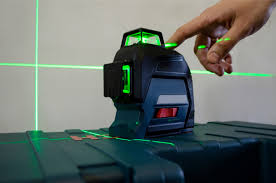
...simple to use, just put it on a camera tripod and wind it up and down to verify the horn pairs are at the same level or the stack is properly aligned longitudinally. Sounds like you could have used one for the shed (ha!). You could use REW (free software) and a relatively inexpensive unit like a Scarlatti 2i2 with a calibrated microphone to align your channels...perhaps easier and more accessible than using Bills Trinnov.
Do you know the sensitivity of the Tannoy Red tweeter? The RAAL Lazy Ribbon is supposed to be 111dB/w/m and it still runs flat out with no attenuation just the losses through a first order filter. A higher order filter requires has more losses and I have to then attenuate the midrange S2 to compensate. The Water Drop at 117dB/w/m? has a whole 6dB more loss to support a higher order filter which is fantastic, but I can't see how the Red tweeter is going to be anywhere near that sensitivity...hopefully I am wrong. That is probably why you are considering the Yamaha amplifiers.
You may have picked up that I am also not 100% happy on the sound of my tweeter. It does sound very good, certainly right up there quality wise, but the room measurements show that I have a minimally delayed reflection in that top octave that I've not spent the time to track down and sort out, as well as needing to fill a shallow but broad droop in the upper frequency response which the biradial horn may help. However, compared to the rest of the horn stack it seems that the highest frequencies are slightly flatter, or slightly slower than midrange and down. That is probably not a useful commentary. Describing physical experiences is often difficult, but perhaps I am starting to understand what you mean about Macondo "not loving you". My fingers are crossed that the biradial horn for the ribbon and the chasing down that early HF reflection will put my mind at ease...but maybe not.
The HF channel brings a LOT to the overall sound, more than I ever would have credited. I listened a long time without it connected (many months) trying to understand the horn stack below those frequencies and I had a very nice sound, but the ribbon brings brought so much more. Adding a DHT second stage to the HF channel for a little more gain has crossed my mind in part because of what the channel actually adds to the sound. My consideration had been to maybe limit it to 2.5V DHT's because much of the wiring etc. is already in place for the tube socket and the YO186 (4V) is going nowhere.
Anyway, those are my thoughts so far. I am sure there were more things I wanted to bring up when watching your video, but alas they are nowhere to be found right now.
|
|
|
|
Posted by Romy the Cat on
06-24-2023
|
Actually, I used laser BMS
multiple times, and I found it completely useless. Yes, I perfectly can set up
my horns with laser us and down or left and right, but I found that and my new
difference, if one of the corns will be even inch higher or lower does not make
too much difference. What I am after is to align the axis of the horns, and to
assure that two horns are complete parallelism. I cannot do it this a laser pointer with high
degree of precision. When I installed my laser pointer at listening position
and tripod, my laser point has very high-quality range Finder, I can mark
exactly position of the laser point at the right and left horn of the same
channel. Then, When I angle the horn at let's say 1 degree in any direction.
The position of the laser pointer moved very slightly. I was using an extension
method, taped, a mirror and reflected the laser pointer to another wall, and
this way I had March larger of laser point movement in case I angle the horn. But
this method seal does not give me that assurance that the horn pointed directly
to two specific reference location. This way I can align right and left channels
to be pointed relative to each other in the same direction but it will not be
assurance that their horns pointed to the best position as a reference baseline.
In case I use multiple channels on right and left it is very lengthy ceremony two
find all proper right left and up and down deviation of laser point reflection.
I did it in the past and I still believe it is the wrong way to do it as there
is absolutely no assurance that my mirror between channels will be attached
perfectly 3D perpendicular to the horn axes. It is not a baffled loudspeaker
and there is no reference vertical surface on the horn to attach the mirror.
Regarding sensitivity. I have no idea what is
the Red’s sensitivity. I guess I can measure it and I might do it. What however
I think it's important to understand, at least the way how I see it, that 100Db
sensitivity with ribbon and 100DB sensitivity with RED are different animals in
my view. The sensitivity is like a winter sun, it shines but it does not
produce warms. They kind of have an intellectual satisfaction by feeling that high
sensitivity assures dynamic range but there is something more sinister with
this and I do not know what it is. It does not feel dynamic or to put it better
its produces different type of dynamics which for whatever reason flushed you
with water but you are still thirsty. It is possible that I have not the best
experiences because I drive in with SET. When I was choosing loading of my Water
Drop Twitter I was mostly driven by measurements, proper integration with S2
and overall proper performance. I think at that time I did not have my
subjective perception is high and the scale of my reference points as I have
now. It is fair to say that later things change over the last 20 years, :-) Yes,
I agree that measurement wise ribbons are spectacular but as Lamm used to teach
me: if you measurements are not aligned with your subjective perceptions then
you measure wrong things. I do not have the technical expertise to dig deeper
into ribbons measurements. Also it is not my objective to discover Truth about ribbons.
All the time need to find proper high frequency transducing for this specific
system to satisfy my personal very subjective perception. It is very important
to note that the problem I'm trying to address, namely “Macondo doesn't love me”
in reality does not even relate to twitters. At this point I just choose the twitters
as a “guilty” party and I am trying to address one hypothesis at time.
|
|
|
|
Posted by Paul S on
06-24-2023
|
Wow, Romy, what a fraught time! You seem to have (somehow) focused on your sound system and narrowed things down to a tweeter, or at least some viable way to add "color". While you were talking, I was thinking that your S2s actually go pretty high, maybe over 15k Hz, right? I always had the opposite problem, with (colorful) paper tweeters that trailed off, and I added 'stats, then ribbons for that effect. I have mentioned here that I always thought that "ribbon manufacturers" "lied" about the ribbon efficiency, but now that you complain about ribbon efficiency, too, I realize that whatever the efficiency turns out to be, it's only the effects that I care about. Testing transducers can take a while! Add tube/amp/X/O sound qualities to the mix and you might have a real Project on your hands!
Good Luck,
Paul S
|
|
|
|
Posted by Romy the Cat on
06-24-2023
|
|
I setup on Macondo/Milq back
by the calibration sheet and tine up all channels. The system up and running with
perfectly trained obedient sound. I like it. There is no tweeter and no ULF The
midbass is running with first order filter at 78Hz, in this new larger bin enclosure
I need to revise it perhaps. Add the Red driver driven by B3. The B3 is rolled down
probably 50DB down. The Red runs own default crossover and +3dB HF output.
There is absolutely no lost of dynamics the I can detect, in fact it scares how
good dynamically, truly scare. The Reds and S2 are NOT time aligned yet. There
is a problem however, as good as Red wonderful atop it has one color and own presentation
style that I detect, and I do not like it ever presentnees. The Dannoy did not have. I wonder why. The
leading hypothesis the something In the Dannoy’s bass make the Redness of Tanoy
to be more controlled….
|
|
|
|
Posted by Amir on
06-25-2023
|
I never listened to DSET/Macondo so I can not comment about the system but to have better love some ideas come to my mind.
In my opinion "more emotion" comes from these area:
1- Tone beauty and tone coherency (amplifiers are important in this area but every audio element in the chain like DAC or Speaker driver or ... all have have their own tone) , many Japan audio designers prefer more simple/minimal designs to have better tone.
2- Micro dynamics
in part 1 (Tone) if the "AC Quality", "Acoustics" and "speaker position" all are Perfect then I think after changing the Ribbon twitter the next step could be considering matching of power amplifier output stage and Speaker Drivers. DSET is more complex than SET.
in part 2 (Micro dynamics) I think the PSU design of power amplifier is important.
|
|
|
|
Posted by Romy the Cat on
06-25-2023
|
1)
Found a way to center Red drive in the frame and
to align the axis of the red driver with midrange S2 driver. It is not so simple
as it might appear.
2)
Spend a week or two to listen the new room and learning
what this new room does. Certainly, the current position of the speaker snot when
they will be, it is pretty much a storage position. they will be moving way
into the room.
3)
Disconnect Red’s driver LF coil, testing the hypothesis
that the coloration coming from LF cone’s Doppler.
4)
Trying to drive S2 driver from B3 amplifier
directly, with no HF filtration of any kind, very curious about the result. Yes,
the idea to drive the whole Macondo from B3 with passive filters did cross my
mind. I am not there yet. I would like to succeed with what I know and THEN to experiment
with what I do not know.
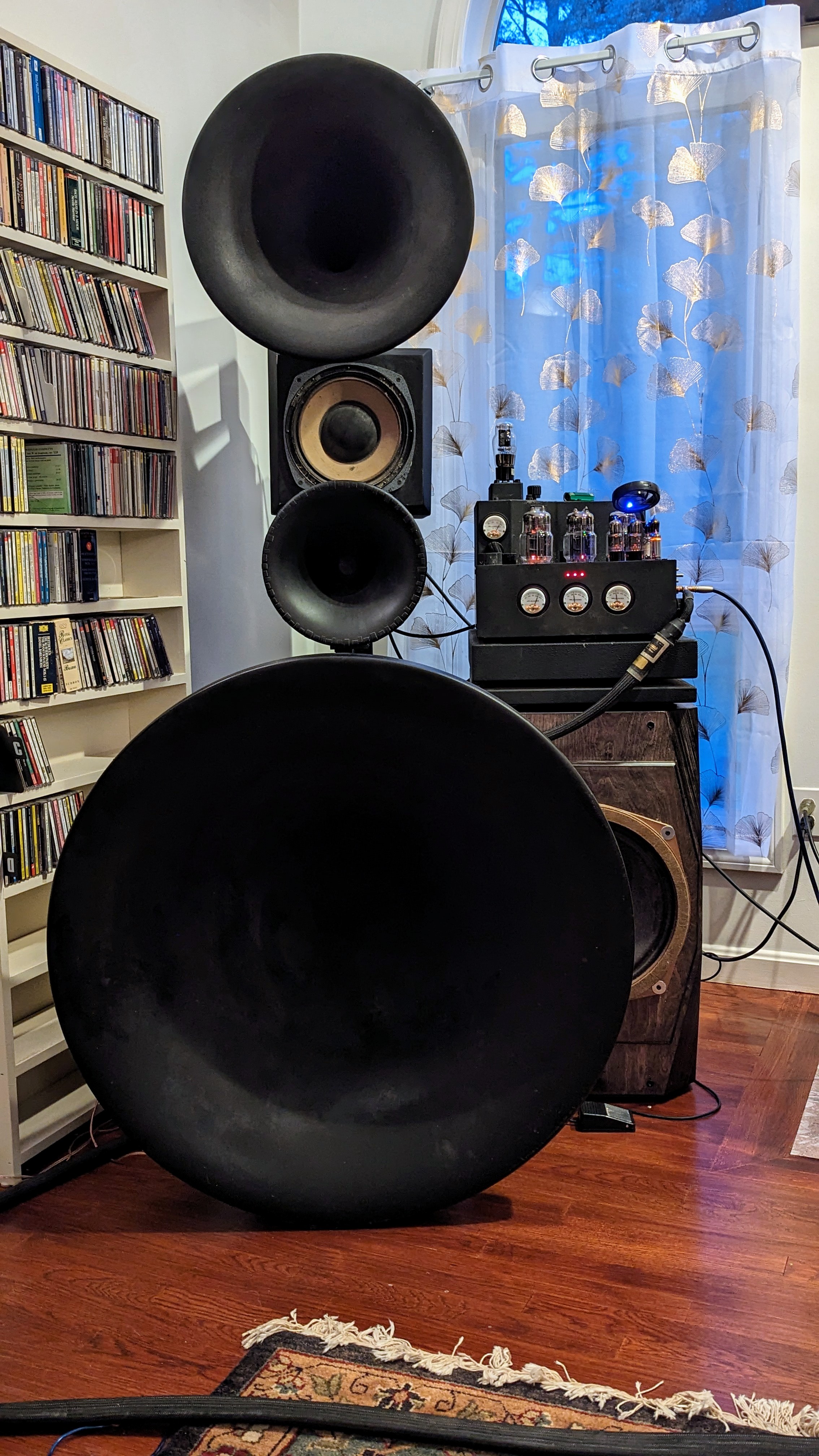
|
|
|
|
Posted by anthony on
06-25-2023
|
Romy, are you presently running a single or dual Vitavox 15" per side? I assume this is.run from a DSET channel? My room has a huge cancellation 60hz-100hz, broad and deep, and when I tried the Vitavox 15" drivers I could get two-fifths of stuff all volume from them...all room related it seems.
Have since put a lot of bass treatment into the room but not remeasured so hopefully that broad cancellation is less broad now and less deep too. Once under control I'll revisit the.midbass channel
|
|
|
|
Posted by Bill on
06-25-2023
|
In his latest YouTube,Romy mentioned using my prepro to time align my drivers.
I use the Trinnov Altitude 16 prepro which has a total of 20 channels. 16 of the channels have balanced analog outputs and the othe four Channels use the rca and optical spdif outputs. Eight of the channels are used as active crossovers to my main horns and the rest for the surround speakers and subwoofers. The unit acts as active crossover, driver frequency correction, phase inversion, time alignment of all drivers and speakers to less than 1/10th of a millisecond, adjustment of frequency curves, speaker distance, volume correction and room correction, plus multiple other corrections. It can store up to 29 different setups. It can then be run as a stereo unit or use Dolby, dts or auro3d processing for surround. The unit then does up to 24/96 adc or dac conversion for analog output.
As far as spatial alignment of the drivers, for approximate driver distances I use a laser distance unit, then the trinnov for accurate distance.I use a flashlight from my listening position to point at each horn's driver to align it perfectly straight to the listener's ear position. In addition, for the horn tweeters, by doing multiple tests with the trinnov, I get the flattest frequency response curve up to 20khz.The altitude has the ability to do room correction from several locations but doing this decreases the accuracy of a single listening position response. I have primary response curves for the four driver stereo horns, plus 7.5.2 curves for video and 6.5.2 for surround audio.
|
|
|
|
Posted by Romy the Cat on
06-25-2023
|
Anthony
As you can see in the picture it is one Vitavox 15" per
side and the box is about 2 feet deep, so it good volume. I drive it from low
frequency Milq channel that has a line-level 63 Hertz filter. Subjectively I
feel that I would like to roll off the Vitavox driver slightly faster. I do not
want to open the amplifiers and change filter as it is has all complexity, as a
filter is integrated with the driver stage bias. I will probably put another
first level filter at speaker level, at least initially. The key is, in my view,
to find a sweet spot where tonally and dynamically upper knee off Vitavox
15" compete with lower knee of upper base horn, and to find which channel
performs best in the octave between 70 and 140 cycles. I do not know the answer
yet, I knew it before but then Vitavox in much smaller box, so I need to do all
those experiments all over again. Ideally, when I find the answer, I would
change it in the driver stage tube of Melquiades as in my view nothing could be
better then to do it line level.
I do not know your room, but I do not believe in acoustic
treatment for low frequency, unless you do monumental architectural changes in
your room. The existing acoustic
treatments do very unproportional treatment as very effective and a higher
frequency. So, when you use them to treat your 100 Hertz they make
reverberation time at 1000 cycles much shorter than you would like it to be as
they're much more effective at higher frequencies. So, for 10% of correction 100
Hertz you create 300% damage at 1kHz. To treat some corners, VERY moderately it
still might be OK but it is about it. My approach to dealing with the problem
like this is very different and I I have written a lot about it. If you have a huge
cancellation at 60hz-100hz, then introduce a dedicated mid bus channel where
you will be able to play with crossovers, slope and phase your we'll be able to
fix this room problem. If you read my Macondo’s axioms then you will see that I
always advocate tonight fight acoustic problems in the room by use them. Find
out the way to use your cancellation at 60hz-100hz for your advantage.
|
|
|
|
Posted by anthony on
06-25-2023
|
I've managed to make my own room treatments thus far, all bass oriented and although some broadband absorption has been used the bulk is effective 30hz - 500hz. It is an architectural type of solution where I have a covered the front and side walls and massively altered low end reverberation time without much changing midrange and top end times nearly as drastically... they are very even now from 40hz -20khz.
The major hurdle I have that most will not is that mine is a soundproof room. I can close a door and the rest of the house has no clue if I have music playing loud... although the closed door is a give away! That sealed room is super bad for room modes as little energy leaks through the walls and it all comes back as cancellations and reinforcements. At the sidewalls , where the TT sits, the 30Hz mode used to be 18db to 21db louder than what came from the bass cannons... since room bass treatment that is now 6db lower than that issued from the speakers...24dB to 27dB attenuation!
As a result, the quality of the bass is superb, almost unbelievably good, but it is also now quieter than it once was as much of what I used to hear was "old news" issued half a second or more ago, so I expect to rebalance the system shortly. This is a long way of saying that I have already bass treated the room as it was the only conceivable way for me to even out the room frequency response without putting literally 1kW of amplifier power into a pair of Vitavox 15" per side, at 75Hz, which of course will not work. A little bit of bass treatment remains to be completed, on the ceiling this time, and then room tuning with diffusion and perhaps some midrange absorption, depending on how things sound.
|
|
|
|
Posted by Romy the Cat on
06-25-2023
|
|
Wow, where did you see a 1kW
amplifier that is able to produce bass that does not make you vomit? Also, why
would you need power like this. If you go with 15” high sensitivity driver,
then you would need 20-30W max. Do not forget that your objective would be not override
the 18db cancellation but very surgically to complement the room in one of
other direction. The key would be not the excursion of your driver but the crossover
pot in right location that will be by own face rotation will get rid of the
room mode. Again, do not fight with the room, use what it has. Also, why it
should be an expensive Vitavox driver? If you detect that the driver should out
a lot of sound then you might go for Vitavox or good vintage Altec, or good
vintage JBL. If you however detect that you need the drive not to “sound” but
to do “phase injection” then you can go with anything smaller and let exotic.
Think about your anti-cancellation chennal as an active room treatment. The sound of the driver is OK but the
selection of proper volume and proper crossover is 75% of success.
|
|
|
|
Posted by Romy the Cat on
07-01-2023
|
tarted to mount the open baffle for ULF channels at my
attic. The system is fully operational,
not time aligned yet to the degree that I would like it to be but I'm going to
tell you: that Tannoy Red 10 is something that makes everything so sweet and
lovely that I have very hi expectations to the result. I use default twitter crossover;
the low frequency cone is not even connected. I have long way to go to make
this Twitter sound right. At this point I use just default crossover end run
weather 6Bb down to Vitavox S2 driver. I am very sure that the final
configuration will be different, but I will go for this after time alignment. I
understand and change crossover point on Red driver will change my time
alignment, so it will leave a lot of room for experiments, mistakes and
findings.
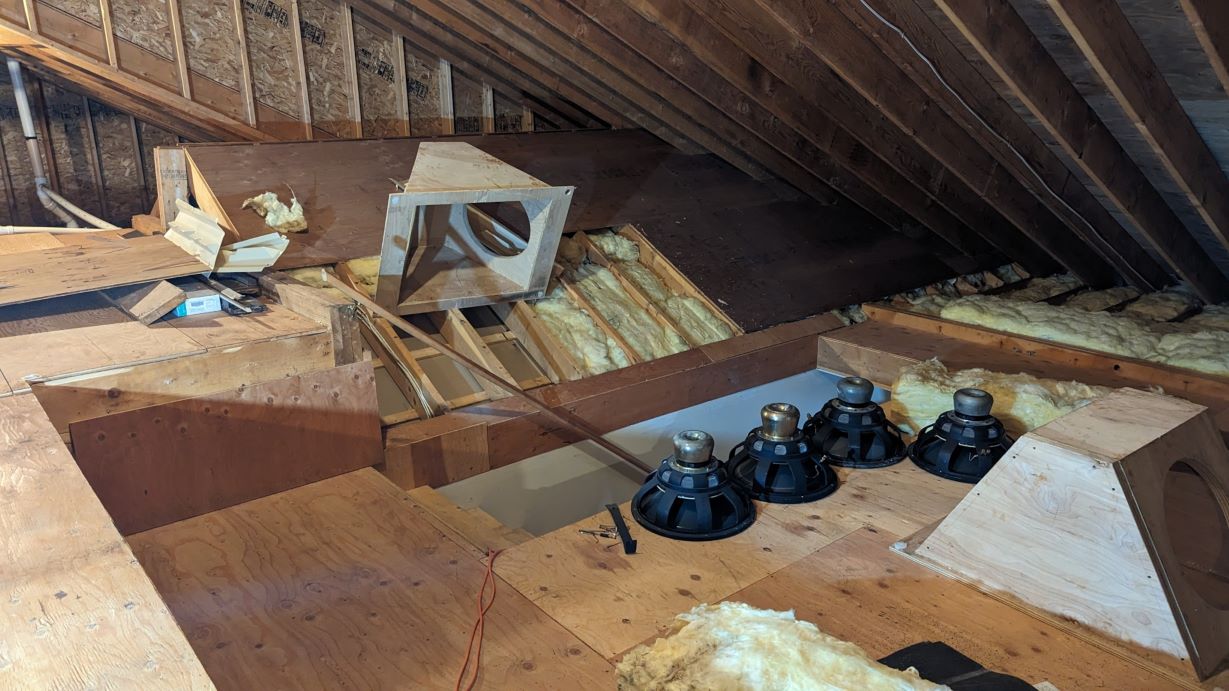
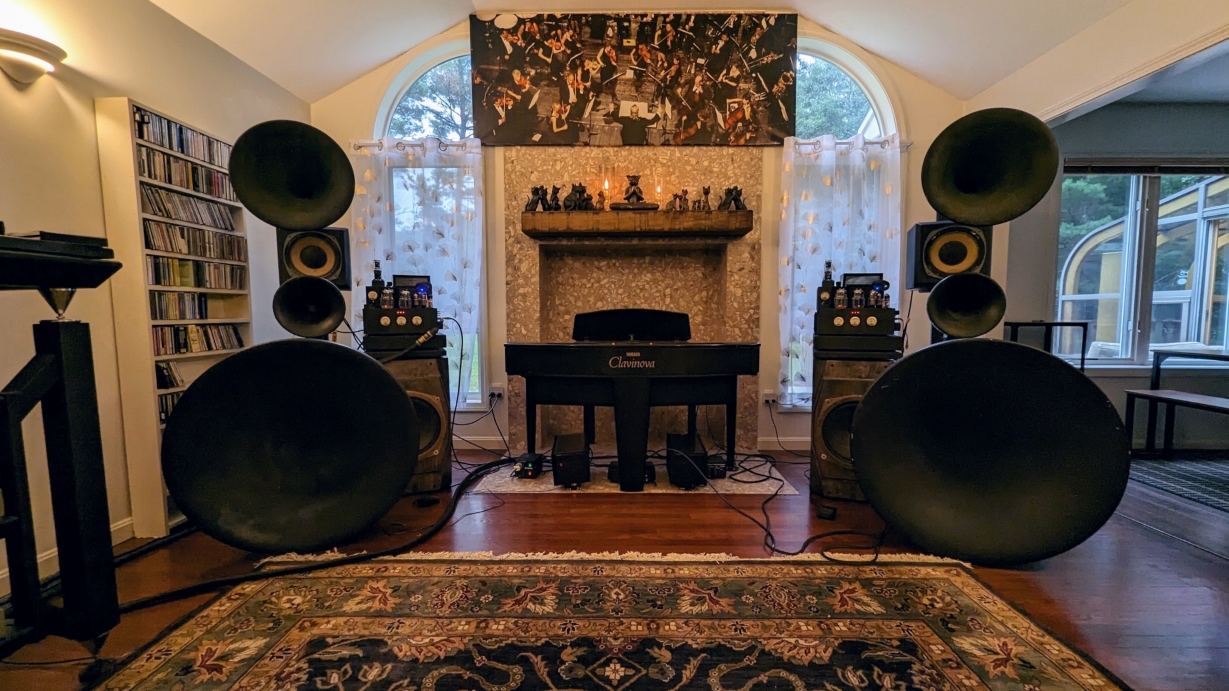
|
|
|
|
Posted by Paul S on
07-01-2023
|
Another giant attic for IB ULF! That can't have happened by chance! Am I the only one who wonders about parking the amps on the woofers?
Best regards,
Paul S
|
|
|
|
Posted by Romy the Cat on
07-02-2023
|
 Paul
S wrote: Paul
S wrote: | | Am I the only one who wonders about parking the amps on the woofers? |
|
From the point of view of a methodological purity indeed the location of a vacuum
tube amplifier atop of midbass section does not make any sense. But also, exists
the empirical practice. I did not experiment with this bass bin, but I did those
experiments with my former bass bins that were 4 time smaller. As you remember I
use the same amps location from 2016. Nope, I did not listen the sound of the amplifiers
siring on the floor vs the amps sitting atop bass enclosure, but I was listening
via stethoscope on the amplifiers chassis if hear the bone vibrations from
woofer. I can testify that I never was able to hear it.
I did not try otherwise by
here and before my upload fire was over sitting atop of a black platform that
you can see on the picture. It is a custom-made vibration decoupling platform made
for me by Kevin from Silent Running Audio. The platform is made for the specific
weight and weight distribution of the amp and has two separate parts. The
bottom part that is sitting on the bass bin is basically a fancy piece of wood.
The top part that hosts the amplifier is floating over the bottom part. Whan, I
say floating it is not literally, but I mean that it has some sort of decoupling.
There was lot of talk in audio media that Keving used some super patented and
super secretive technologies that were used in USA submarines to decouple noise
producing elements of the sub from the sub’s hull. I think that is BS that
audio writers invented. In reality, I am not sure how it worked, even though I spoke
with Kevin in length. I might do not remember correctly but he used a hydraulic
decoupling, and the liquid are special chemicals that detect vibrations and change
own viscosity, effectively offsetting the vibration resonance.
I got the platforms from
Keving in 2000 for my ML2s and I never use my amps without them, luckily the ML2
and Milq have the same weight and mass distribution. I did some experiments
with them back in 2001 and all my experiments ended one day. I put the beautifully
sound Micro Seiki RX-5000 atop of SRA platform and it was an absolute magic:
the turntable lost bass and not just “become worse” but it lost probably 20db
at the bottom. It was a truly a “holly shit experience” and I instantly understood
that somehow the SRA platforms worked. I invited the statoscope to approach later
when I designed the Melquiades chassis. I still feel that even the presence of some
bone vibration does not necessarily impact sound in a predicable negative way. If
you hard couple a mic to your tonearm body and with MC cartridge and blast the full
volume of your playback (I did) then on s scope of the mic feed, you will see
that it picks up a lot of air vibrations. So, how to deal with it?
Anyhow, I do feel that there
is a lot of truly actionable problems that I would like to deal with my playback,
and I do not feel that the apps siting atop of the midbass bins is one of them.
Perhaps my pride of building the 6ch Melquiades and my pleasure to look on it overrides
my sense of methodological audio purity. Perhaps. But I am confronted with the
fact the if I do not hear anything with a statoscope then there is nothing to worry
about. It might be a good idea to add a
vibration sensor to the amp and to see objectively what is going on but I feel
that a pursuit of “perfection” frequently mans a paralysis of progress and have
other objectives to chase.
|
|
|
|
Posted by Paul S on
07-03-2023
|
I did notice the platforms, and I figured it was something like this, since we've all heard the feedback loop that can happen, and we learn "what not to do" that way. Regarding your TT loosing LF atop a platform, I wrote here about my CD transport being weird atop an "anti-vibration" platform. As it happens, that transport has "special feet" built it, and I think two levels of anti-vibration under one device might be one too many. I also think a given platform has to be tuned to a particular frequency range. I use damping for my tone arm, and when it's not right, I hear it. Of course, if it's not a problem, then I am only too happy to just forget about it. In fact, I pretty much treat all my "treatments" that way. As for "perfection", I am OK with "acceptable". It seems I do, however, have to solve recurring problems periodically, and I am not always sure why.
All the above in the context of your speakers, of course!
Best regards,
Paul S
|
|
|
|
Posted by Romy the Cat on
07-03-2023
|
Got the right channel open baffle installed. It's certainly
not finished cosmetically but it is fully functional. There is nothing measured
or calibrated But I spent quite a few hours listening last night. It is very
very very interesting result. The room sounds very responsive and very
forgiving. I typically do not like rooms when speakers are installed across a
short wall. However, something does works in my case, I use just half length of
the room end my listening space is 19 by 19 feet with another 20~ feet behind my
listening spot. Could it be the best listening
room I’ve bult? I certainly hope but for now it is too early to say. One way or
another it is certain now that the number of bass with the amplification I have
will be fine for the size of the room. The house is 2000 sq feet with another 2000
in the basement and 2000 of attic. It is wide open for bass; I was a bit worrying
that I would need more power and more gains in ULF channels. Nope I will not. It
looks like I will be rolling the ULF amps somewhere around minus 810 dB and the
right baffle installed will give me extra DBs. So, I all set with the ULF. Now
I need to discover some strength in me to put my lazy and voluptuous body back
to attic and to install the left channel.
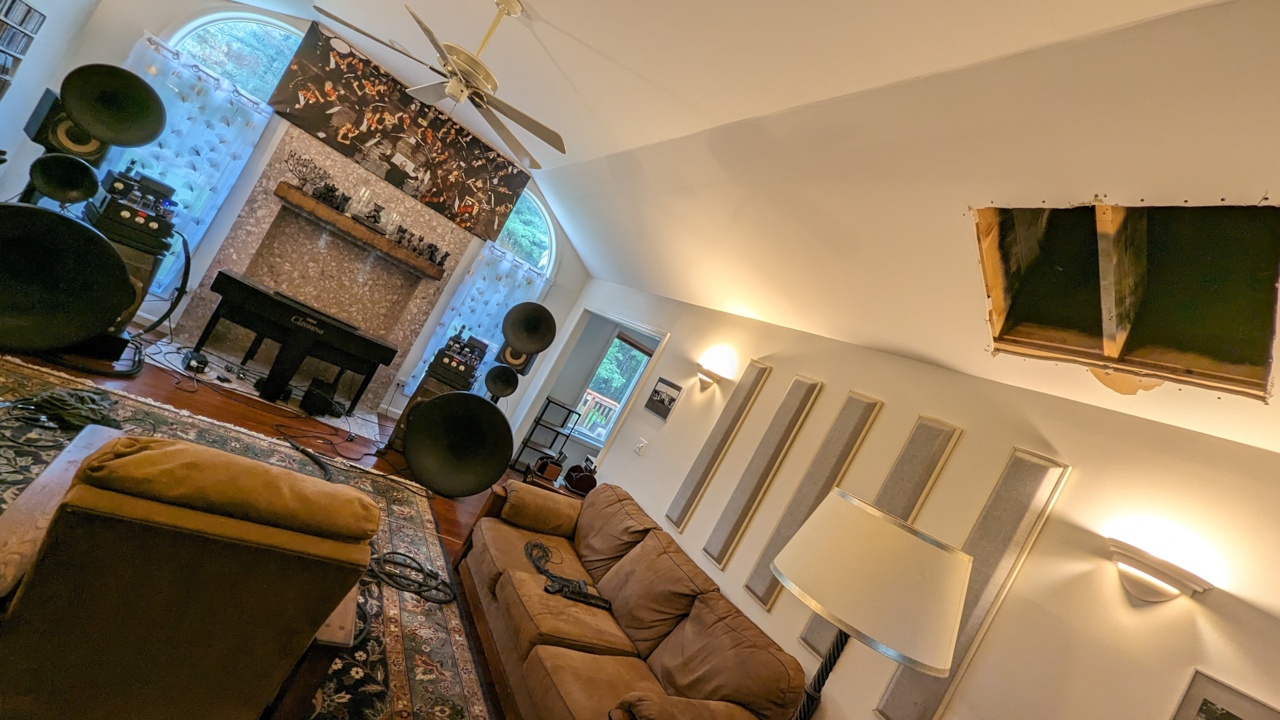
|
|
|
|
Posted by anthony on
07-03-2023
|
That attic is a lot of space to perhaps return to a midbass horn, should you be so inclined.
Is the IB ULF run from DSET or a separate amplifier?
|
|